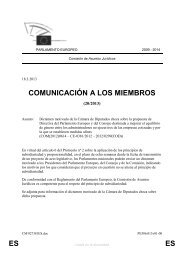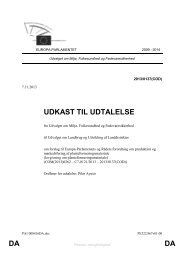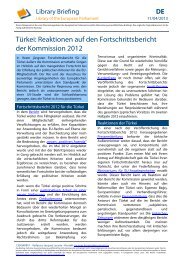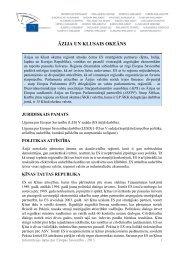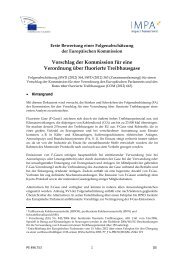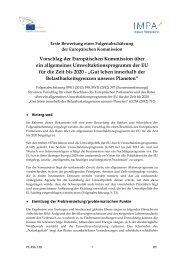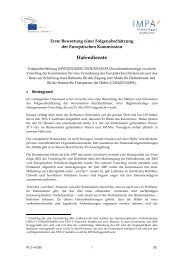Link to the study - European Parliament - Europa
Link to the study - European Parliament - Europa
Link to the study - European Parliament - Europa
You also want an ePaper? Increase the reach of your titles
YUMPU automatically turns print PDFs into web optimized ePapers that Google loves.
Policy Department D: Budgetary Affairs<br />
____________________________________________________________________________________________<br />
Figure 36: External PMU design and its roles<br />
Source: Authors<br />
That brought <strong>the</strong> managing institutions in<strong>to</strong> a complex and intransparent situation and limited <strong>the</strong>ir<br />
sense of responsibility:<br />
The national administration, controlling <strong>the</strong> managing organisation, had no complete control<br />
over <strong>the</strong> PMU’s activities, as part of <strong>the</strong> PMU was controlled by EBRD.<br />
The consultant company did not bear responsibility for <strong>the</strong> decisions prepared by <strong>the</strong> PMU<br />
(strategic decisions, <strong>to</strong> be decided by a control institution) and taken (operational decisions, <strong>to</strong><br />
be made by <strong>the</strong> management level of <strong>the</strong> managing organisation) or for those being in any way<br />
adequate, correct or appropriate. The only risk taken over was that <strong>the</strong> contract with EBRD failed,<br />
was delayed or <strong>the</strong> cus<strong>to</strong>mer (EBRD) was not satisfied with <strong>the</strong> work provided. None of <strong>the</strong>se<br />
risks has <strong>to</strong> do with <strong>the</strong> success or failure of <strong>the</strong> decommissioning process and <strong>the</strong> decisions <strong>to</strong><br />
be taken and <strong>the</strong>ir risk.<br />
The external experts in <strong>the</strong> PMU had no obligation <strong>to</strong> report <strong>to</strong> <strong>the</strong> national administration and<br />
no formal right <strong>to</strong> do so, even if requested, because <strong>the</strong>ir (and <strong>the</strong> external consultant company)<br />
was formally a consultant for EBRD, and had no mandate from, obligations in respect <strong>to</strong> or<br />
reporting requirements <strong>to</strong>wards <strong>the</strong> managing organisation or its control institution.<br />
In this structure responsibilities for management decisions, be <strong>the</strong>y of a strategic or an operative<br />
character (see chapter 2.4.3), were<br />
In-transparently attributed (who prepares proposals for projects or strategic decisions <strong>to</strong> be<br />
taken, who decides on those proposals and on which legitimation basis, with which quality<br />
and reliability are those <strong>to</strong> be prepared and decided, etc.);<br />
Completely mixed (<strong>the</strong> difference between strategic and operational decisions got lost, <strong>the</strong><br />
awareness of responsibilities is unclear, for insiders as well as for outsiders);<br />
In-transparently deployed over five different institutions, all responsible or not for selective<br />
parts of <strong>the</strong> whole process.<br />
The decision <strong>to</strong> install those units on this unclear basis nei<strong>the</strong>r streng<strong>the</strong>ned <strong>the</strong> national<br />
administration’s nor <strong>the</strong> managing organisation’s sense of responsibility. This was even fur<strong>the</strong>r<br />
weakened by <strong>the</strong> fact that for most of <strong>the</strong> strategic (see chapter 2.4.3) and as well for all operational<br />
110




